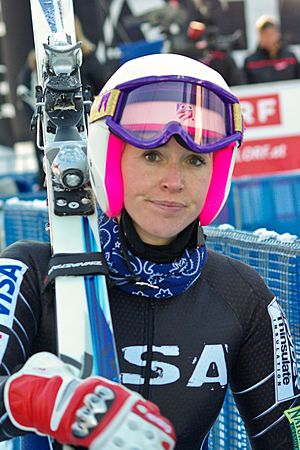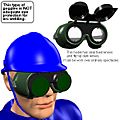Ski goggles facts for kids
Ski goggles are special glasses that protect your eyes when you are skiing or snowboarding. They keep your eyes safe from the bright sun, wind, snow, and even small bits of ice. Wearing ski goggles helps you see clearly on the slopes, which is super important for staying safe and having fun!
Contents
Why Ski Goggles Are Important
Ski goggles are a key part of your ski gear, just like your helmet and skis. They protect your eyes from many things:
- Sunlight: Snow reflects a lot of sunlight, which can be very bright. Ski goggles have special lenses that block harmful UV rays and reduce glare. This helps prevent eye strain and damage.
- Wind and Snow: When you ski fast, the wind can make your eyes water, making it hard to see. Goggles also keep snow, ice, and cold air out of your eyes.
- Impact: If you fall or something flies up from the snow, goggles offer a layer of protection for your eyes.
Lenses and How They Work
Ski goggle lenses are usually made from strong, soft plastic like polycarbonate. This material is tough and less likely to shatter than glass.
Different Lens Colors
You might notice ski goggles come with lenses in many different colors. Each color helps you see best in different weather conditions:
- Dark Lenses (like black, grey, or mirrored): These are best for very sunny days because they block a lot of light.
- Light Lenses (like yellow, orange, or rose): These are great for cloudy days or when it's snowing. They help make bumps and shadows on the snow easier to see.
- Clear Lenses: These are used for night skiing or very low-light conditions.
Anti-Fog Technology
One common problem with ski goggles is that they can fog up, making it hard to see. This happens when warm, moist air from your face meets the cold lens. To stop this, many goggles have:
- Double Lenses: Two lenses with a small air gap between them, which acts like a windowpane to insulate and prevent fog.
- Anti-Fog Coatings: A special layer on the inside of the lens that stops moisture from sticking and forming fog.
- Vents: Small openings around the goggle frame that allow air to flow through, helping to clear moisture.
Wearing Goggles with Glasses
If you wear glasses, you can still wear ski goggles! Many brands make "OTG" (Over The Glasses) goggles. These goggles are designed to be a bit bigger and have special cut-outs in the foam to fit comfortably over your regular glasses without squishing them. This way, you don't have to choose between seeing clearly and protecting your eyes.
How to Take Care of Your Goggles
To make your ski goggles last a long time and stay clear, it's important to take good care of them:
- Storage: Always store your ski goggles in a soft bag or case when you're not using them. This protects the lenses from scratches.
- Cleaning: If your lenses get dirty, use a special goggle cloth or a very soft, clean cloth to wipe them gently. Avoid using paper towels or rough fabrics, as these can scratch the lens or remove the anti-fog coating.
- Drying: After a day on the slopes, let your goggles air dry completely before putting them away. Don't use a heater or direct heat, as this can damage the foam or lens.
Images for kids
-
A U.S. Army Belgian Malinois wearing Doggles to protect his eyes from dust in Afghanistan
-
Traditional Inuit goggles made of caribou antler, used to combat snow blindness
See also
 In Spanish: Gafas protectoras para niños
In Spanish: Gafas protectoras para niños









